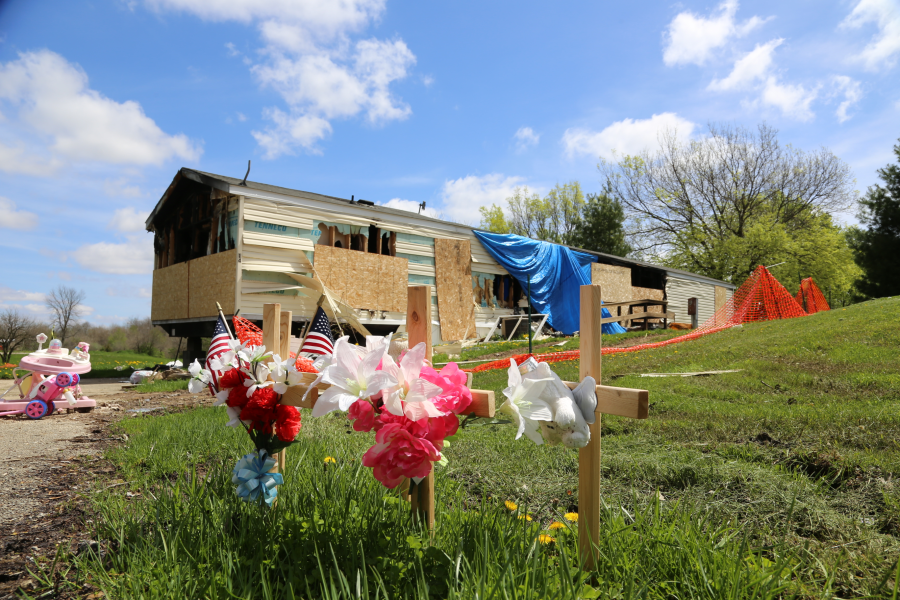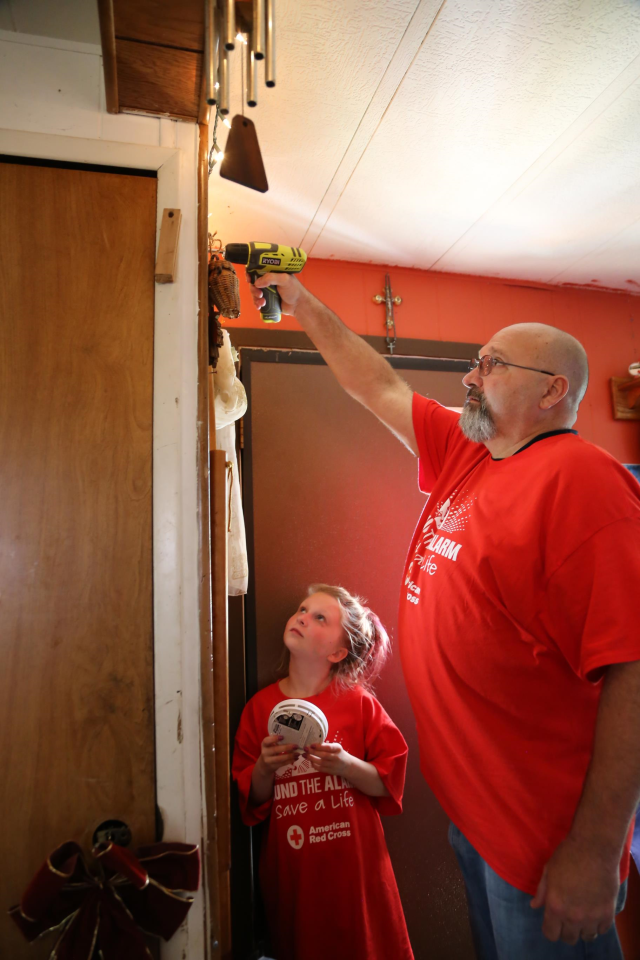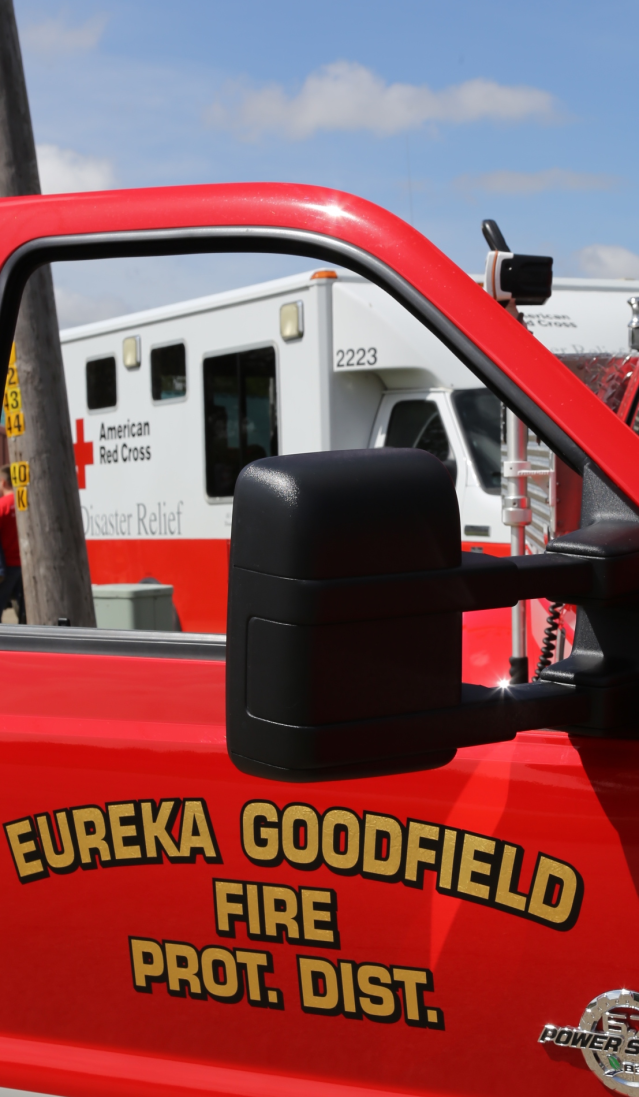 The first official blast of wintry weather is in the forecast for later this week and now is the perfect time to review winter preparedness tips to help you and your family stay safe throughout this winter season.
The first official blast of wintry weather is in the forecast for later this week and now is the perfect time to review winter preparedness tips to help you and your family stay safe throughout this winter season.
WEATHER ALERTS AND FIRST AID TIPS
 People can download the Red Cross Emergency App for instant access to winter storm tips and weather alerts for their area and where loved-ones live. Expert medical guidance and a hospital locator are included in the First Aid App in case travelers encounter any mishaps. Both apps are available to download for free in app stores or at redcross.org/apps
People can download the Red Cross Emergency App for instant access to winter storm tips and weather alerts for their area and where loved-ones live. Expert medical guidance and a hospital locator are included in the First Aid App in case travelers encounter any mishaps. Both apps are available to download for free in app stores or at redcross.org/apps
HOME HEATING SAFETY
Have furnaces, chimneys, fireplaces, wood and coal stoves inspected and cleaned before another winter of use. Test batteries in smoke and carbon monoxide detectors. Other good steps to take to get one’s home ready for winter include:
- Make sure flashlights are available throughout the house and they have fresh batteries. Winter storms can lead to power outages.
- Insulate the home by installing storm windows or covering the inside of windows with plastic to keep frigid air out.
- Develop a fire escape plan and practice it with everyone who lives in the home.
- Prepare a disaster supply kit to have ready should winter storms hit. The kit should include a three-day supply of food and water per person, flashlight, battery-powered or hand-crank radio and extra batteries. Other things to have on hand for the winter include:
- Sand, rock salt or kitty litter to make walkways and steps less slippery
- Warm coats, gloves or mittens, hats, boots and warm clothing for all household members, along with extra blankets.
- Winterize your vehicle.
- Consider buying emergency heating equipment, such as a wood- or coal-burning stove or an electric or kerosene heater.
Nearly half of the households in this country use alternative heating sources such as space heaters, fireplaces, or wood/coal stoves to stay warm. Fixed and portable space heaters, including wood stoves, are involved in 74 percent of fire-related deaths.
If someone is using a space heater, the Red Cross recommends that people look for a model that shuts off automatically if the heater falls over. Space heaters should be placed on a level, hard and nonflammable surface in the home.
Other safety tips include:
- Keep all potential sources of fuel like paper, clothing, bedding, curtains or rugs at least three feet away from space heaters, stoves, or fireplaces.
- Portable heaters and fireplaces should never be left unattended. Turn off space heaters and make sure any embers in the fireplace are extinguished before going to bed or leaving home.
- Keep children and pets away from space heaters.
GET YOUR VEHICLE READY FOR WINTER
Plan ahead. Have a mechanic check your tires, battery, brakes and antifreeze levels. Make sure your vehicle is ready for winter with a window scraper, shovel, kitty litter or sand in case you get stuck, extra clothes and an Emergency Kit in your trunk. Pack high-protein snacks, water, first aid kit, flashlight, small battery-operated radio, an emergency contact card with names and phone numbers, extra prescription medications, blankets and important documents or information you may need.
DRIVING IN WINTER
While the Red Cross encourages you to stay off the road if possible, if you have to drive in snow or freezing rain, follow these tips about how to drive safely during a winter storm and what to do if you become stuck in your vehicle:
- Fill the vehicle’s gas tank and clean the lights and windows to help you see.
- Pay attention to the weather forecast. Before you leave, let someone know where you are going, the route you plan to take, and when you expect to get there. If your car gets stuck, help can be sent along your predetermined route.
- If you have to drive, make sure everyone has their seat belts on and give your full attention to the road. Avoid distractions such as cell phones.
- Don’t follow other vehicles too closely. Sudden stops are difficult on snowy roadways.
- Don’t use cruise control when driving in winter weather.
- Don’t pass snow plows.
- Know that ramps, bridges and overpasses will freeze before roadways.
If you become stuck in the snow or icy conditions:
- Stay with the car. Do not try to walk to safety.
- Tie a brightly colored cloth (preferably red) to the antenna for rescuers to see.
- Don’t run your engine and heater constantly to help avoid running out of gas. Don’t use things like lights or the radio without the engine running so the battery doesn’t conk out.
- If you can, move your vehicle off the roadway. Stay with it – don’t abandon it. If you have to get out of your vehicle, use the side away from traffic.
- Start the car and use the heater for about 10 minutes every hour. Keep the exhaust pipe clear so fumes won’t back up in the car.
- Leave the overhead light on when the engine is running to help rescuers see the vehicle.
- Keep one window slightly open – away from the blowing wind – to let in air.
EMERGENCY KIT
 Being prepared means being equipped with the proper supplies you may need in the event of an emergency or disaster. Keep your supplies in an easy-to-carry kit or backpack that you can use at home or take with you in case you must evacuate.
Being prepared means being equipped with the proper supplies you may need in the event of an emergency or disaster. Keep your supplies in an easy-to-carry kit or backpack that you can use at home or take with you in case you must evacuate.
At a minimum, you should have the basic supplies listed below:
- Water: one gallon per person, per day (3-day supply for evacuation, 2-week supply for home)
- Food: non-perishable, easy-to-prepare items (3-day supply for evacuation, 2-week supply for home).
- Flashlight
- Extra batteries
- Battery-powered or hand-crank NOAA Weather Radio
- First aid kit
- Medication (7-day supply) and medical items
- Multi-purpose tool
- Sanitation and personal hygiene items
- Copies of personal documents (medication list and pertinent medical information, proof of address, deed/lease to home, passports, birth certificates, insurance policies)
- Cell phone chargers
- Family and emergency contact information
- Extra cash
- Blankets
- Family and emergency contact information
Consider the needs of all family members and add supplies to your kit. Suggested items to help meet additional needs are:
- Medical supplies (hearing aids with extra batteries, glasses, contact lenses, syringes, etc.)
- Baby supplies (bottles, formula, baby food, diapers)
- Games and activities for children
- Pet supplies (collar, leash, ID, food, carrier, bowl)
- Manual can opener
- Two-way radios
- Extra set of car and house keys
Additional supplies to keep at home or in your survival kit based on the types of disasters common to your area:
- Whistle
- Surgical masks
- Matches
- Rain/winter gear
- Towels
- Work gloves
- Supplies for securing your home
- Extra clothing, hat and study shoes or boots
- Plastic sheeting
- Duct tape
- Scissors
- Bleach
- Plastic sheeting
WINTER PET CARE

Winter weather is difficult on our pets and the American Red Cross has steps people can follow to help ensure their pet’s safety over winter season.
Other tips pet owners should be aware of include:
- Salt and other chemicals used to melt snow and ice can irritate a pet’s paws. Wipe their paws with a damp towel before your pet licks them and irritates their mouth.
- Antifreeze is a deadly poison. Wipe up spills and store antifreeze out of reach.
- Signs of frostbite include discoloration of the frozen area, pale or even blue skin, no pain or lots of pain. The pads of the paws, tail and tips of the ears are most susceptible. If your pet has frostbite, bring them out of the cold immediately. Spray the affected area with warm water. Lightly apply a warm compress to the area. Do not rub or apply pressure. Take your pet to your veterinarian immediately.
If pet owners would like additional information, download the American Red Cross Pet First Aid App: The app provides dog and cat owners with resources on how to maintain their pet’s health and well-being and what to do during emergencies until veterinary care is available. Owners have access to step-by-step instructions, videos and images from more than 25 common first aid and emergency situations including what to do for cold-related emergencies.
Features in the app allow owners to:
- Find emergency pet care facilities or alternate veterinarians if they are out of town with the animal hospital locator.
- Locate pet-friendly hotels.
- Test their knowledge with interactive quizzes and earn badges that they can share on their social networks. They can also attach their favorite picture of their pet when they share their badge.
The app is available to download for free in app stores, by going to redcross.org/apps or by texting ‘GETPET’ to 90999.






 The first official blast of wintry weather is in the forecast for later this week and now is the perfect time to review winter preparedness tips to help you and your family stay safe throughout this winter season.
The first official blast of wintry weather is in the forecast for later this week and now is the perfect time to review winter preparedness tips to help you and your family stay safe throughout this winter season. People can download the
People can download the  Being prepared means being equipped with the proper supplies you may need in the event of an emergency or disaster. Keep your supplies in an easy-to-carry kit or backpack that you can use at home or take with you in case you must evacuate.
Being prepared means being equipped with the proper supplies you may need in the event of an emergency or disaster. Keep your supplies in an easy-to-carry kit or backpack that you can use at home or take with you in case you must evacuate.